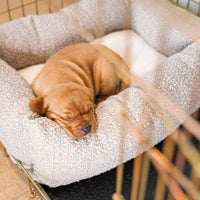As the seasons change and we find ourselves in the midst of autumn and approaching winter, the days grow shorter, and darkness descends upon us earlier.
For dog owners, this shift in daylight hours can present a challenge when it comes to walking our furry companions. Walking your dog at night during these darker months can still be a delightful experience, offering tranquility and cooler temperatures, but it also brings its own unique set of challenges.
To ensure a safe and enjoyable night walk with your dog as we enter the autumn and winter seasons, it's crucial to be well-prepared and take the necessary precautions, including the use of reflective gear for dog walking. In this article, we will provide you with 8 expert tips to help you navigate the changing seasons and walk your dog safely at night.
1. Invest in Reflective Gear
Investing in reflective gear for dog walking is essential for night-time outings. Outfit your dog with a reflective collar, lead, or harness to make them more visible to passing vehicles. We recommend the Zoon flash and go rechargeable collar, it comes in multiple sizes and is super adjustable so you’re sure to get the right fit. Similarly, consider wearing reflective clothing or accessories yourself to enhance your visibility to others.
2. Stay on Familiar Paths
Walking your dog at night is not the best time to explore new and unfamiliar paths. Stick to routes that you and your dog are well-acquainted with to reduce the risk of stumbling or getting lost.
3. Keep Your Dog On The Lead
Even if your dog is well-behaved off-lead during daytime walks, it's advisable to keep them on the lead at night. This provides better control and prevents them from wandering into potential dangers, like roads or other animals.
4. Choose Well-Lit Areas
Opt for well-lit routes whenever possible. Walking in areas with streetlights or well-illuminated paths can significantly enhance safety during your night-time dog walks.
5. Carry Essentials
Pack essentials such as a torch, poo bags, and a fully charged phone with emergency numbers programmed in. These items will prove invaluable if you encounter any unexpected situations.
6. Train Your Dog
Before embarking on night walks, ensure your dog is well-trained and responsive to commands like "stop," "stay," and "come." A well-trained dog is easier to manage in low-light conditions.
7. Stay Aware
Maintain situational awareness throughout your walk. Keep an eye out for potential hazards, such as uneven paths, potholes, or other pedestrians. Additionally, be cautious of wildlife that may be more active at night.
8. Be Prepared for Weather Changes
Weather conditions can change rapidly at night, so check the forecast before heading out and dress appropriately. Bring extra layers, an umbrella, or rain gear as needed to ensure both you and your dog stay comfortable.
Walking your dog at night can be a wonderful experience, provided you prioritise safety and preparedness. By following these 8 expert tips and using reflective gear for dog walking, you can enjoy the benefits of night-time dog walks while minimising the risks. Remember that your safety and the safety of your canine companion should always come first, so take every precaution to ensure a safe and enjoyable night walk.



























































.jpg?v=1696856071880&options=)










































